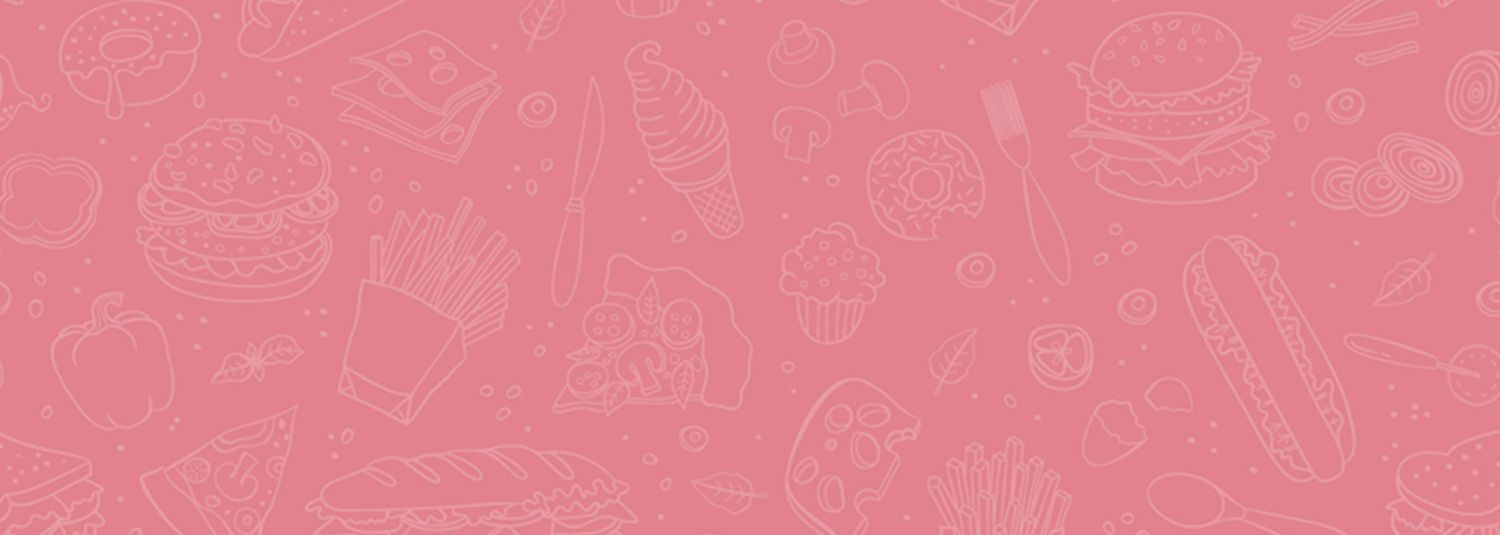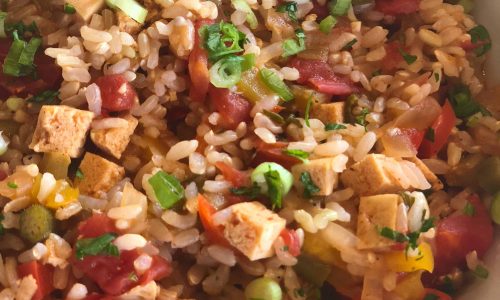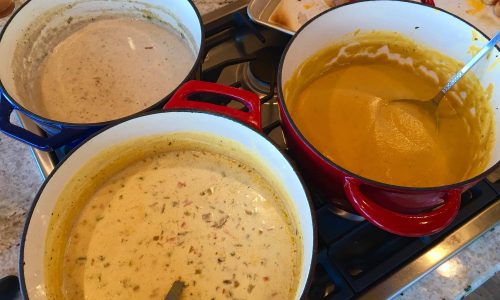We had a surprise drill when we came into class. Make a 2 egg omelet–no utensils of course.
I was not afraid because I had practiced several times at home and I had actually watched Julia Child’s original TV recording of the omelet show. She demonstrates over and over how to make an omelet with nothing but the pan and the movement you create. I mixed my 2 eggs with a little kosher salt and water, added clarified butter to the pan and heated it. It looked hot enough so I poured in the eggs and they immediately stuck to the pan! Chef Sively took the spatula and lifted the edges for me (thanks!) and then I recovered and made the omelet without anything but the pan and my arm. It turned out pretty good but I need to practice. AND make sure the pan is hot enough! We were given some advance warning that the first week of CP3 we’ll be expected to make a perfect omelet, French onion soup, roux, risotto, eggs benedict, and demonstrate our knife skills. Time to start practicing!
Cake class was interesting. We learned the difference between foam cakes and high ratio cakes.
Foam cakes rely on whipped eggs for leavening whereas high ratio cakes rely on creamed fat.
Butter cakes are also known as creaming-method cakes. These are our typical birthday cakes and are supposed to be tender, yet sturdy enough to hold fillings and frosting. For a cake that needs to be rolled or sliced into very thin layers, the foam cake works much better. These cakes, called genoise, spongecakes, angel food cakes, and chiffon cakes, can be used as the building blocks to create multi-layered torts. As with all cakes, both butter and foam, can fail miserably due to any number of problems including undermixing, overmixing, undercooking, overcooking, not right temperature, etc. This is probably why cake mixes are so popular. But, a really well made butter cake is a wonderful thing I learned.
I have made many cakes in my life and some have been outstanding. I make a wonderful Italian cream cake, great carrot cake, outstanding German chocolate cake, and many others, but I never had a recipe for a good versatile basic butter cake, nor did I ever think of having a good basic cake to use to create other things. That’s the reason culinary school is so great–it opens your eyes to new ways of thinking about things you already know.
For class we were given the following assignment:
Magnificent Moist Golden Cake–creaming method
Magnificent Moist Golden Cake-two-stage method
Magnificent Moist Golden Cake–dissolved sugar method
Classic Genoise
Orange Chiffon Cake
Angel Food Cake
Chocolate Sponge Layer
Joconde Sponge Cake
American Poundcake
Each table made all 3 golden cakes and then we chose just one other type of cake. I chose pound cake.
I worked on the dissolved sugar method cake and it turned out really well. It is so moist and tasty–but the two-stage method cake, made by Matt, was the best. It really was melt-in-the-mouth moist.
Recipe
2 large eggs (3.5 oz) at room temperature
3 large egg yolks (1.95 oz) at room temperature
1/3 cup buttermilk, divided
2 tsp vanilla extract
1 3/4 cups (7.1 oz) spooned and leveled cake flour (you have to use cake flour or it won’t work)
1 1/2 cups (10 oz) sugar
1 3/4 tsp baking powder
1/2 tsp salt
4 T unsalted butter, cut into 1 T pieces and slightly softened
1/2 cup canola oil
1/2 cup heavy cream
Preheat oven to 350. Spray 9 inch round cake pan with nonstick spray with flour and line with parchment circle.
Stir eggs, yolks, 3 T of the buttermilk and vanilla together in a medium bowl.
Mix together the flour, sugar, baking powder, and salt in a mixer with the whisk attachment on low speed for 30 seconds. Add the butter and oil and remaining 2 T buttermilk. Mix on low speed to moisten, then increase to medium and beat 1 1/2 min. Scrape down sides and bottom of bowl. Add 1/3 of the egg mixture and beat for 20 seconds. Repeat, adding thirds until all egg mixture is incorporated. Scrape down sides after each addition.
In a cold bowl with cold beaters, whip the cream until soft peaks form and then beat a little beyond this soft peak stage. Stir about 1/4 of the whipped cream into the batter to lighten it, then fold the rest of the whipped cream into the batter.
Pour the batter into the prepared pan. Drop the pan onto the counter from a height of 4 inches to knock out bubbles. Place cake in oven and bake until toothpick comes out clean but moist, about 40 minutes. Cool on rack 10 min, then invert cake on rack that has been sprayed with nonstick spray. Peel off parchment. Cool completely before slicing into layers. Enjoy!
We also discussed our upcoming projects for the 3 weeks we will be making the “finished products”. We will take things we’ve learned from previous weeks and using components we have stored in the freezer, such as sauces and fillings, doughs, etc. and fresh sauces and garnishes, we will make at least 6 finished products. We had to discuss and decide on our finished products in class so Chef Kurima can determine if they are reasonable and then make sure the ingredients we need are available the days of class. We have to make the following categories:
Stirred custard
Baked custard
Cake
Pie
Laminated Dough
For stirred custard I’m make a lime-mango curd, for baked custard, chocolate pots de creme, for cake, a coconut, lime-mango poundcake with Italian meringue, and pie a banana cream pie, and for laminated dough, blitz puff pastry with which I will made chocolate croissants. I will also make a free form apple peach and frangipane tart with peach coulis and some berry turnovers.
Wow, that sounds like a lot of work, but it is over 3 classes so it’s not so bad. I will start testing some recipes at home.
I was not afraid because I had practiced several times at home and I had actually watched Julia Child’s original TV recording of the omelet show. She demonstrates over and over how to make an omelet with nothing but the pan and the movement you create. I mixed my 2 eggs with a little kosher salt and water, added clarified butter to the pan and heated it. It looked hot enough so I poured in the eggs and they immediately stuck to the pan! Chef Sively took the spatula and lifted the edges for me (thanks!) and then I recovered and made the omelet without anything but the pan and my arm. It turned out pretty good but I need to practice. AND make sure the pan is hot enough! We were given some advance warning that the first week of CP3 we’ll be expected to make a perfect omelet, French onion soup, roux, risotto, eggs benedict, and demonstrate our knife skills. Time to start practicing!
Cake class was interesting. We learned the difference between foam cakes and high ratio cakes.
Foam cakes rely on whipped eggs for leavening whereas high ratio cakes rely on creamed fat.
Butter cakes are also known as creaming-method cakes. These are our typical birthday cakes and are supposed to be tender, yet sturdy enough to hold fillings and frosting. For a cake that needs to be rolled or sliced into very thin layers, the foam cake works much better. These cakes, called genoise, spongecakes, angel food cakes, and chiffon cakes, can be used as the building blocks to create multi-layered torts. As with all cakes, both butter and foam, can fail miserably due to any number of problems including undermixing, overmixing, undercooking, overcooking, not right temperature, etc. This is probably why cake mixes are so popular. But, a really well made butter cake is a wonderful thing I learned.
I have made many cakes in my life and some have been outstanding. I make a wonderful Italian cream cake, great carrot cake, outstanding German chocolate cake, and many others, but I never had a recipe for a good versatile basic butter cake, nor did I ever think of having a good basic cake to use to create other things. That’s the reason culinary school is so great–it opens your eyes to new ways of thinking about things you already know.
For class we were given the following assignment:
Magnificent Moist Golden Cake–creaming method
Magnificent Moist Golden Cake-two-stage method
Magnificent Moist Golden Cake–dissolved sugar method
Classic Genoise
Orange Chiffon Cake
Angel Food Cake
Chocolate Sponge Layer
Joconde Sponge Cake
American Poundcake
Each table made all 3 golden cakes and then we chose just one other type of cake. I chose pound cake.
I worked on the dissolved sugar method cake and it turned out really well. It is so moist and tasty–but the two-stage method cake, made by Matt, was the best. It really was melt-in-the-mouth moist.
Recipe
2 large eggs (3.5 oz) at room temperature
3 large egg yolks (1.95 oz) at room temperature
1/3 cup buttermilk, divided
2 tsp vanilla extract
1 3/4 cups (7.1 oz) spooned and leveled cake flour (you have to use cake flour or it won’t work)
1 1/2 cups (10 oz) sugar
1 3/4 tsp baking powder
1/2 tsp salt
4 T unsalted butter, cut into 1 T pieces and slightly softened
1/2 cup canola oil
1/2 cup heavy cream
Preheat oven to 350. Spray 9 inch round cake pan with nonstick spray with flour and line with parchment circle.
Stir eggs, yolks, 3 T of the buttermilk and vanilla together in a medium bowl.
Mix together the flour, sugar, baking powder, and salt in a mixer with the whisk attachment on low speed for 30 seconds. Add the butter and oil and remaining 2 T buttermilk. Mix on low speed to moisten, then increase to medium and beat 1 1/2 min. Scrape down sides and bottom of bowl. Add 1/3 of the egg mixture and beat for 20 seconds. Repeat, adding thirds until all egg mixture is incorporated. Scrape down sides after each addition.
In a cold bowl with cold beaters, whip the cream until soft peaks form and then beat a little beyond this soft peak stage. Stir about 1/4 of the whipped cream into the batter to lighten it, then fold the rest of the whipped cream into the batter.
Pour the batter into the prepared pan. Drop the pan onto the counter from a height of 4 inches to knock out bubbles. Place cake in oven and bake until toothpick comes out clean but moist, about 40 minutes. Cool on rack 10 min, then invert cake on rack that has been sprayed with nonstick spray. Peel off parchment. Cool completely before slicing into layers. Enjoy!
We also discussed our upcoming projects for the 3 weeks we will be making the “finished products”. We will take things we’ve learned from previous weeks and using components we have stored in the freezer, such as sauces and fillings, doughs, etc. and fresh sauces and garnishes, we will make at least 6 finished products. We had to discuss and decide on our finished products in class so Chef Kurima can determine if they are reasonable and then make sure the ingredients we need are available the days of class. We have to make the following categories:
Stirred custard
Baked custard
Cake
Pie
Laminated Dough
For stirred custard I’m make a lime-mango curd, for baked custard, chocolate pots de creme, for cake, a coconut, lime-mango poundcake with Italian meringue, and pie a banana cream pie, and for laminated dough, blitz puff pastry with which I will made chocolate croissants. I will also make a free form apple peach and frangipane tart with peach coulis and some berry turnovers.
Wow, that sounds like a lot of work, but it is over 3 classes so it’s not so bad. I will start testing some recipes at home.
Angel food cake was underdone and fell out of the pan. Oops!

Magnificent butter cake cooling. It was really good!




